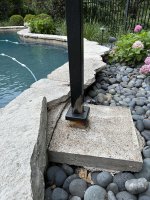- Jan 30, 2023
- 111
- Pool Size
- 29000
- Surface
- Plaster
- Chlorine
- Salt Water Generator
- SWG Type
- Pentair Intellichlor IC-40
I'm new to all this and could use some advice. Our handyman was powerwashing our patio and stone coping caps and I think must have accidentally sprayed under the coping and dislodged some loose grout, as 2 tiles were on the bottom of the pool the next morning. 3 issues for advice:
- Replacing the tiles. See attached 1st photo showing the exposed gunite with rough thinset and some missing pebble finish and 2nd photo of the tile with some of the pebble finish attached. Does the fix here require dropping water level below the tile, removing the old rough thinset from the gunite and from the back of the tile, applying new thinset, attaching the tile, allowing to cure, then re-filling the pool? What about the missing pebble finish? I could probably live with how it looks to be missing a small piece there but will that cause problems? If so, how do you replace it?
- Missing vertical grout in partially submerged gap. See attached 3rd & 4th photos showing each side of the skimmer--1 with grout in-tact and 1 missing the grout. I'm assuming it's important to replace the missing grout, right? If so, what should I use?
- Extensive cracks in above-water line horizontal grout between the coping and the tile all around the pool. See attached 5th photo. Given this is above water-line, do I need to do anything with this? If so, what?











